Federation University: Tobacco National Strategy Essay Analysis
VerifiedAdded on 2022/09/18
|11
|2511
|21
Essay
AI Summary
This essay provides an analysis of Australia's Tobacco National Strategy, a long-standing public health campaign aimed at reducing smoking rates. The introduction outlines the strategy's goals: to create a healthy and resilient Australian community by preventing tobacco-related harms. The essay then delves into the social determinants of health, including education, occupation, income, social capital, and living conditions, and how these factors influence tobacco use and overall health outcomes. The discussion examines the impact of working conditions, education, and income on health, and how these factors relate to the national tobacco strategy's effectiveness. The essay concludes by emphasizing the importance of public awareness and government support for the strategy's continued success in reducing tobacco use and its associated health risks, highlighting the need for comprehensive interventions that address the social determinants of health to achieve lasting positive change.
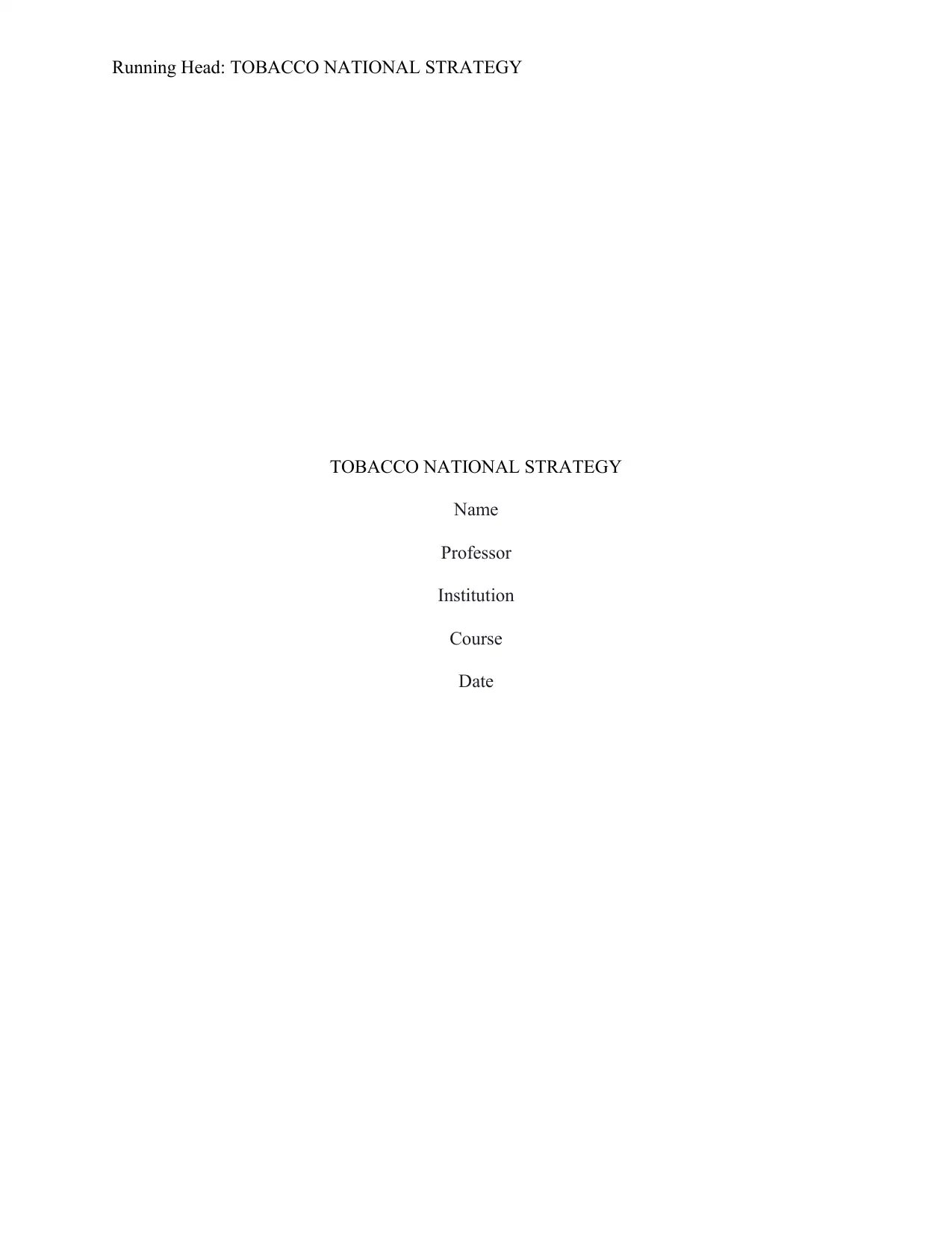
Running Head: TOBACCO NATIONAL STRATEGY
TOBACCO NATIONAL STRATEGY
Name
Professor
Institution
Course
Date
TOBACCO NATIONAL STRATEGY
Name
Professor
Institution
Course
Date
Paraphrase This Document
Need a fresh take? Get an instant paraphrase of this document with our AI Paraphraser
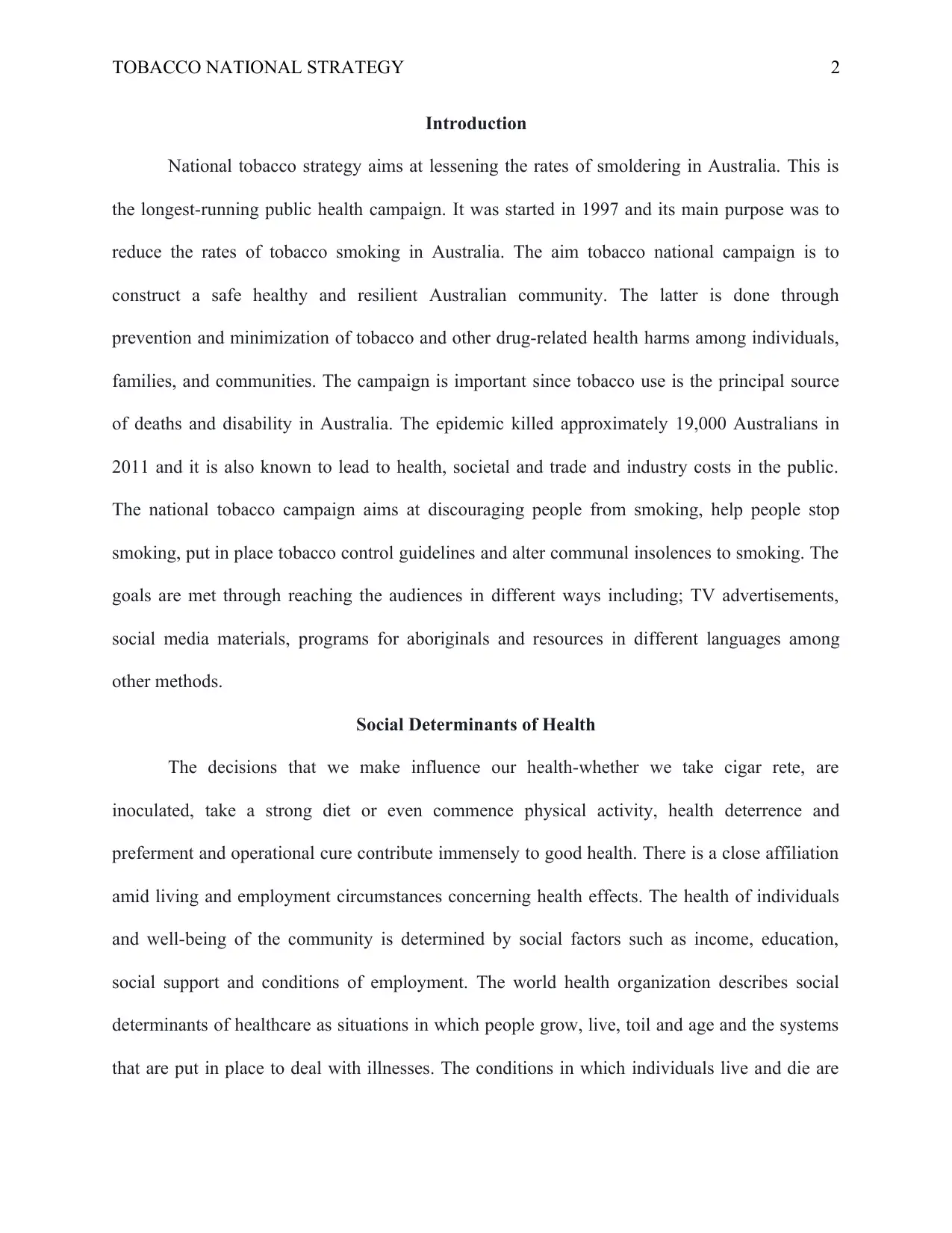
TOBACCO NATIONAL STRATEGY 2
Introduction
National tobacco strategy aims at lessening the rates of smoldering in Australia. This is
the longest-running public health campaign. It was started in 1997 and its main purpose was to
reduce the rates of tobacco smoking in Australia. The aim tobacco national campaign is to
construct a safe healthy and resilient Australian community. The latter is done through
prevention and minimization of tobacco and other drug-related health harms among individuals,
families, and communities. The campaign is important since tobacco use is the principal source
of deaths and disability in Australia. The epidemic killed approximately 19,000 Australians in
2011 and it is also known to lead to health, societal and trade and industry costs in the public.
The national tobacco campaign aims at discouraging people from smoking, help people stop
smoking, put in place tobacco control guidelines and alter communal insolences to smoking. The
goals are met through reaching the audiences in different ways including; TV advertisements,
social media materials, programs for aboriginals and resources in different languages among
other methods.
Social Determinants of Health
The decisions that we make influence our health-whether we take cigar rete, are
inoculated, take a strong diet or even commence physical activity, health deterrence and
preferment and operational cure contribute immensely to good health. There is a close affiliation
amid living and employment circumstances concerning health effects. The health of individuals
and well-being of the community is determined by social factors such as income, education,
social support and conditions of employment. The world health organization describes social
determinants of healthcare as situations in which people grow, live, toil and age and the systems
that are put in place to deal with illnesses. The conditions in which individuals live and die are
Introduction
National tobacco strategy aims at lessening the rates of smoldering in Australia. This is
the longest-running public health campaign. It was started in 1997 and its main purpose was to
reduce the rates of tobacco smoking in Australia. The aim tobacco national campaign is to
construct a safe healthy and resilient Australian community. The latter is done through
prevention and minimization of tobacco and other drug-related health harms among individuals,
families, and communities. The campaign is important since tobacco use is the principal source
of deaths and disability in Australia. The epidemic killed approximately 19,000 Australians in
2011 and it is also known to lead to health, societal and trade and industry costs in the public.
The national tobacco campaign aims at discouraging people from smoking, help people stop
smoking, put in place tobacco control guidelines and alter communal insolences to smoking. The
goals are met through reaching the audiences in different ways including; TV advertisements,
social media materials, programs for aboriginals and resources in different languages among
other methods.
Social Determinants of Health
The decisions that we make influence our health-whether we take cigar rete, are
inoculated, take a strong diet or even commence physical activity, health deterrence and
preferment and operational cure contribute immensely to good health. There is a close affiliation
amid living and employment circumstances concerning health effects. The health of individuals
and well-being of the community is determined by social factors such as income, education,
social support and conditions of employment. The world health organization describes social
determinants of healthcare as situations in which people grow, live, toil and age and the systems
that are put in place to deal with illnesses. The conditions in which individuals live and die are
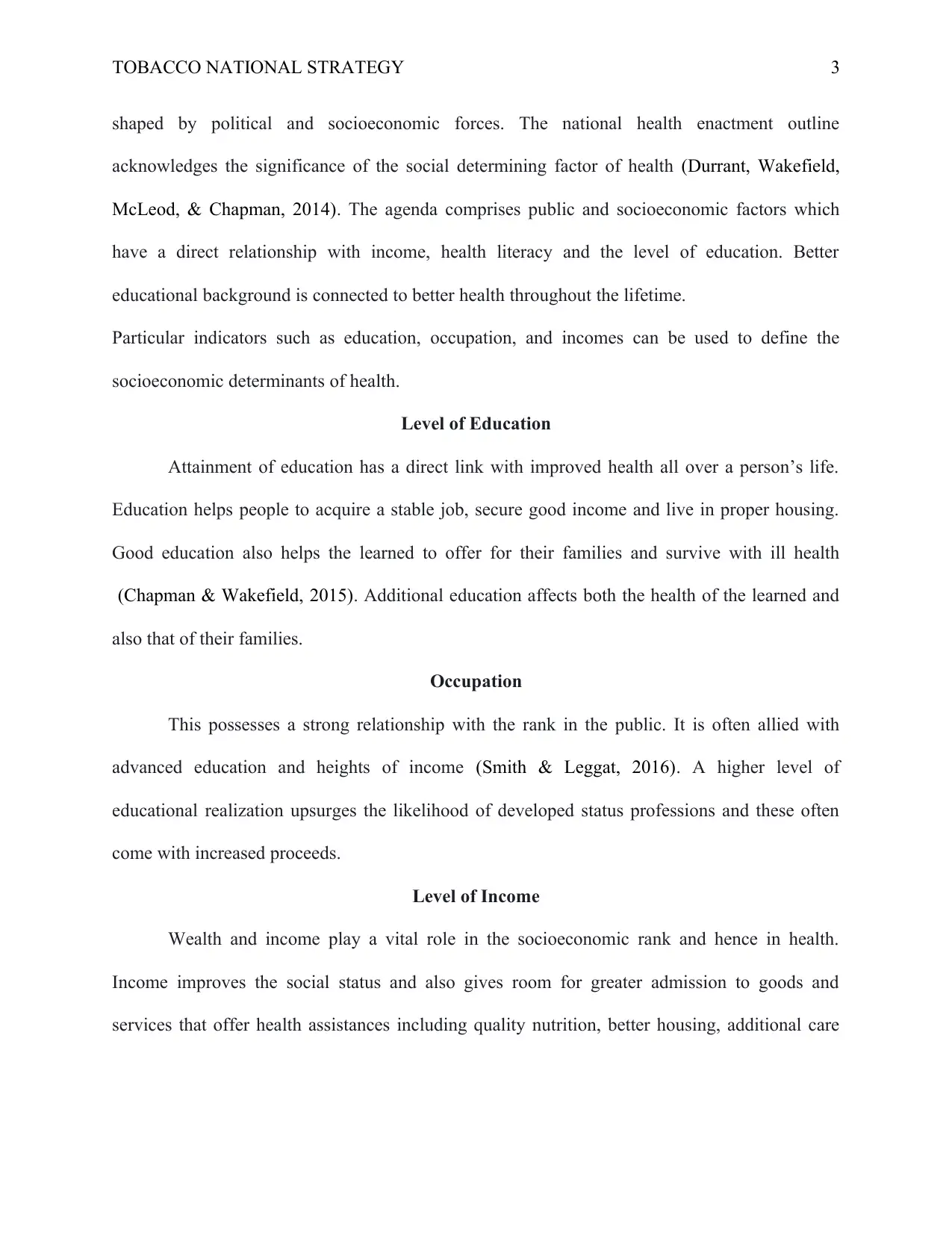
TOBACCO NATIONAL STRATEGY 3
shaped by political and socioeconomic forces. The national health enactment outline
acknowledges the significance of the social determining factor of health (Durrant, Wakefield,
McLeod, & Chapman, 2014). The agenda comprises public and socioeconomic factors which
have a direct relationship with income, health literacy and the level of education. Better
educational background is connected to better health throughout the lifetime.
Particular indicators such as education, occupation, and incomes can be used to define the
socioeconomic determinants of health.
Level of Education
Attainment of education has a direct link with improved health all over a person’s life.
Education helps people to acquire a stable job, secure good income and live in proper housing.
Good education also helps the learned to offer for their families and survive with ill health
(Chapman & Wakefield, 2015). Additional education affects both the health of the learned and
also that of their families.
Occupation
This possesses a strong relationship with the rank in the public. It is often allied with
advanced education and heights of income (Smith & Leggat, 2016). A higher level of
educational realization upsurges the likelihood of developed status professions and these often
come with increased proceeds.
Level of Income
Wealth and income play a vital role in the socioeconomic rank and hence in health.
Income improves the social status and also gives room for greater admission to goods and
services that offer health assistances including quality nutrition, better housing, additional care
shaped by political and socioeconomic forces. The national health enactment outline
acknowledges the significance of the social determining factor of health (Durrant, Wakefield,
McLeod, & Chapman, 2014). The agenda comprises public and socioeconomic factors which
have a direct relationship with income, health literacy and the level of education. Better
educational background is connected to better health throughout the lifetime.
Particular indicators such as education, occupation, and incomes can be used to define the
socioeconomic determinants of health.
Level of Education
Attainment of education has a direct link with improved health all over a person’s life.
Education helps people to acquire a stable job, secure good income and live in proper housing.
Good education also helps the learned to offer for their families and survive with ill health
(Chapman & Wakefield, 2015). Additional education affects both the health of the learned and
also that of their families.
Occupation
This possesses a strong relationship with the rank in the public. It is often allied with
advanced education and heights of income (Smith & Leggat, 2016). A higher level of
educational realization upsurges the likelihood of developed status professions and these often
come with increased proceeds.
Level of Income
Wealth and income play a vital role in the socioeconomic rank and hence in health.
Income improves the social status and also gives room for greater admission to goods and
services that offer health assistances including quality nutrition, better housing, additional care
⊘ This is a preview!⊘
Do you want full access?
Subscribe today to unlock all pages.

Trusted by 1+ million students worldwide
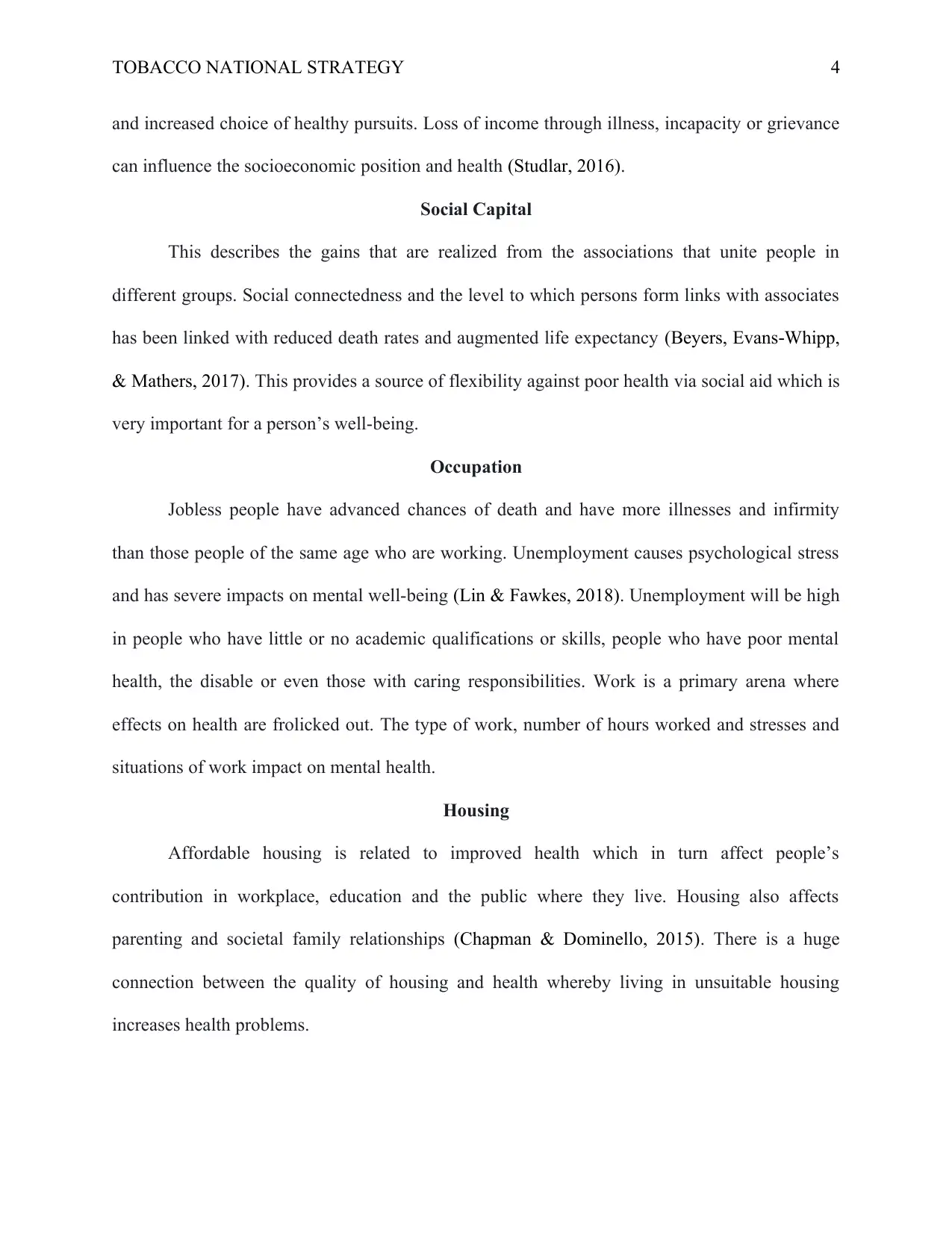
TOBACCO NATIONAL STRATEGY 4
and increased choice of healthy pursuits. Loss of income through illness, incapacity or grievance
can influence the socioeconomic position and health (Studlar, 2016).
Social Capital
This describes the gains that are realized from the associations that unite people in
different groups. Social connectedness and the level to which persons form links with associates
has been linked with reduced death rates and augmented life expectancy (Beyers, Evans Whipp,‐
& Mathers, 2017). This provides a source of flexibility against poor health via social aid which is
very important for a person’s well-being.
Occupation
Jobless people have advanced chances of death and have more illnesses and infirmity
than those people of the same age who are working. Unemployment causes psychological stress
and has severe impacts on mental well-being (Lin & Fawkes, 2018). Unemployment will be high
in people who have little or no academic qualifications or skills, people who have poor mental
health, the disable or even those with caring responsibilities. Work is a primary arena where
effects on health are frolicked out. The type of work, number of hours worked and stresses and
situations of work impact on mental health.
Housing
Affordable housing is related to improved health which in turn affect people’s
contribution in workplace, education and the public where they live. Housing also affects
parenting and societal family relationships (Chapman & Dominello, 2015). There is a huge
connection between the quality of housing and health whereby living in unsuitable housing
increases health problems.
and increased choice of healthy pursuits. Loss of income through illness, incapacity or grievance
can influence the socioeconomic position and health (Studlar, 2016).
Social Capital
This describes the gains that are realized from the associations that unite people in
different groups. Social connectedness and the level to which persons form links with associates
has been linked with reduced death rates and augmented life expectancy (Beyers, Evans Whipp,‐
& Mathers, 2017). This provides a source of flexibility against poor health via social aid which is
very important for a person’s well-being.
Occupation
Jobless people have advanced chances of death and have more illnesses and infirmity
than those people of the same age who are working. Unemployment causes psychological stress
and has severe impacts on mental well-being (Lin & Fawkes, 2018). Unemployment will be high
in people who have little or no academic qualifications or skills, people who have poor mental
health, the disable or even those with caring responsibilities. Work is a primary arena where
effects on health are frolicked out. The type of work, number of hours worked and stresses and
situations of work impact on mental health.
Housing
Affordable housing is related to improved health which in turn affect people’s
contribution in workplace, education and the public where they live. Housing also affects
parenting and societal family relationships (Chapman & Dominello, 2015). There is a huge
connection between the quality of housing and health whereby living in unsuitable housing
increases health problems.
Paraphrase This Document
Need a fresh take? Get an instant paraphrase of this document with our AI Paraphraser
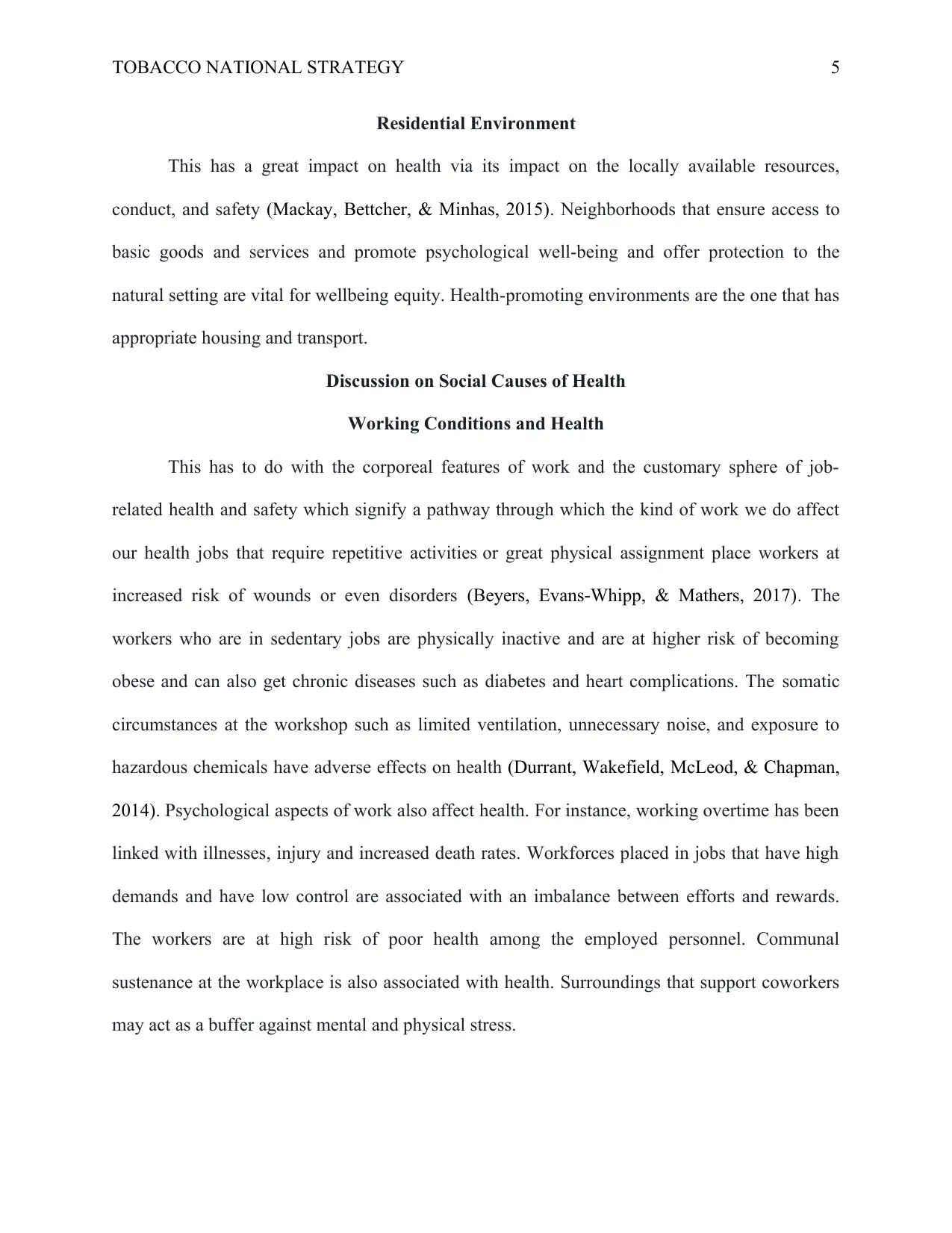
TOBACCO NATIONAL STRATEGY 5
Residential Environment
This has a great impact on health via its impact on the locally available resources,
conduct, and safety (Mackay, Bettcher, & Minhas, 2015). Neighborhoods that ensure access to
basic goods and services and promote psychological well-being and offer protection to the
natural setting are vital for wellbeing equity. Health-promoting environments are the one that has
appropriate housing and transport.
Discussion on Social Causes of Health
Working Conditions and Health
This has to do with the corporeal features of work and the customary sphere of job-
related health and safety which signify a pathway through which the kind of work we do affect
our health jobs that require repetitive activities or great physical assignment place workers at
increased risk of wounds or even disorders (Beyers, Evans Whipp, & Mathers, 2017)‐ . The
workers who are in sedentary jobs are physically inactive and are at higher risk of becoming
obese and can also get chronic diseases such as diabetes and heart complications. The somatic
circumstances at the workshop such as limited ventilation, unnecessary noise, and exposure to
hazardous chemicals have adverse effects on health (Durrant, Wakefield, McLeod, & Chapman,
2014). Psychological aspects of work also affect health. For instance, working overtime has been
linked with illnesses, injury and increased death rates. Workforces placed in jobs that have high
demands and have low control are associated with an imbalance between efforts and rewards.
The workers are at high risk of poor health among the employed personnel. Communal
sustenance at the workplace is also associated with health. Surroundings that support coworkers
may act as a buffer against mental and physical stress.
Residential Environment
This has a great impact on health via its impact on the locally available resources,
conduct, and safety (Mackay, Bettcher, & Minhas, 2015). Neighborhoods that ensure access to
basic goods and services and promote psychological well-being and offer protection to the
natural setting are vital for wellbeing equity. Health-promoting environments are the one that has
appropriate housing and transport.
Discussion on Social Causes of Health
Working Conditions and Health
This has to do with the corporeal features of work and the customary sphere of job-
related health and safety which signify a pathway through which the kind of work we do affect
our health jobs that require repetitive activities or great physical assignment place workers at
increased risk of wounds or even disorders (Beyers, Evans Whipp, & Mathers, 2017)‐ . The
workers who are in sedentary jobs are physically inactive and are at higher risk of becoming
obese and can also get chronic diseases such as diabetes and heart complications. The somatic
circumstances at the workshop such as limited ventilation, unnecessary noise, and exposure to
hazardous chemicals have adverse effects on health (Durrant, Wakefield, McLeod, & Chapman,
2014). Psychological aspects of work also affect health. For instance, working overtime has been
linked with illnesses, injury and increased death rates. Workforces placed in jobs that have high
demands and have low control are associated with an imbalance between efforts and rewards.
The workers are at high risk of poor health among the employed personnel. Communal
sustenance at the workplace is also associated with health. Surroundings that support coworkers
may act as a buffer against mental and physical stress.
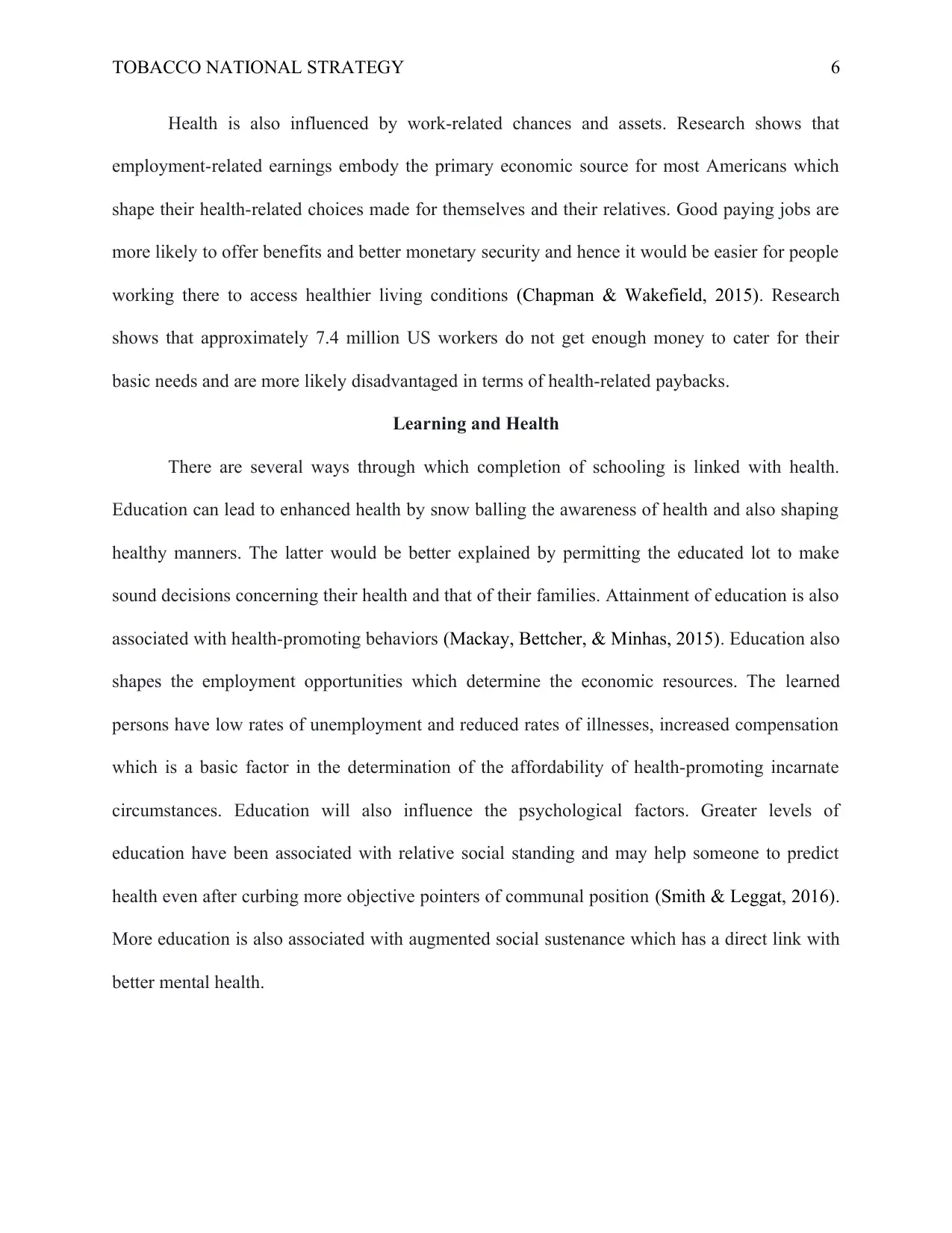
TOBACCO NATIONAL STRATEGY 6
Health is also influenced by work-related chances and assets. Research shows that
employment-related earnings embody the primary economic source for most Americans which
shape their health-related choices made for themselves and their relatives. Good paying jobs are
more likely to offer benefits and better monetary security and hence it would be easier for people
working there to access healthier living conditions (Chapman & Wakefield, 2015). Research
shows that approximately 7.4 million US workers do not get enough money to cater for their
basic needs and are more likely disadvantaged in terms of health-related paybacks.
Learning and Health
There are several ways through which completion of schooling is linked with health.
Education can lead to enhanced health by snow balling the awareness of health and also shaping
healthy manners. The latter would be better explained by permitting the educated lot to make
sound decisions concerning their health and that of their families. Attainment of education is also
associated with health-promoting behaviors (Mackay, Bettcher, & Minhas, 2015). Education also
shapes the employment opportunities which determine the economic resources. The learned
persons have low rates of unemployment and reduced rates of illnesses, increased compensation
which is a basic factor in the determination of the affordability of health-promoting incarnate
circumstances. Education will also influence the psychological factors. Greater levels of
education have been associated with relative social standing and may help someone to predict
health even after curbing more objective pointers of communal position (Smith & Leggat, 2016).
More education is also associated with augmented social sustenance which has a direct link with
better mental health.
Health is also influenced by work-related chances and assets. Research shows that
employment-related earnings embody the primary economic source for most Americans which
shape their health-related choices made for themselves and their relatives. Good paying jobs are
more likely to offer benefits and better monetary security and hence it would be easier for people
working there to access healthier living conditions (Chapman & Wakefield, 2015). Research
shows that approximately 7.4 million US workers do not get enough money to cater for their
basic needs and are more likely disadvantaged in terms of health-related paybacks.
Learning and Health
There are several ways through which completion of schooling is linked with health.
Education can lead to enhanced health by snow balling the awareness of health and also shaping
healthy manners. The latter would be better explained by permitting the educated lot to make
sound decisions concerning their health and that of their families. Attainment of education is also
associated with health-promoting behaviors (Mackay, Bettcher, & Minhas, 2015). Education also
shapes the employment opportunities which determine the economic resources. The learned
persons have low rates of unemployment and reduced rates of illnesses, increased compensation
which is a basic factor in the determination of the affordability of health-promoting incarnate
circumstances. Education will also influence the psychological factors. Greater levels of
education have been associated with relative social standing and may help someone to predict
health even after curbing more objective pointers of communal position (Smith & Leggat, 2016).
More education is also associated with augmented social sustenance which has a direct link with
better mental health.
⊘ This is a preview!⊘
Do you want full access?
Subscribe today to unlock all pages.

Trusted by 1+ million students worldwide
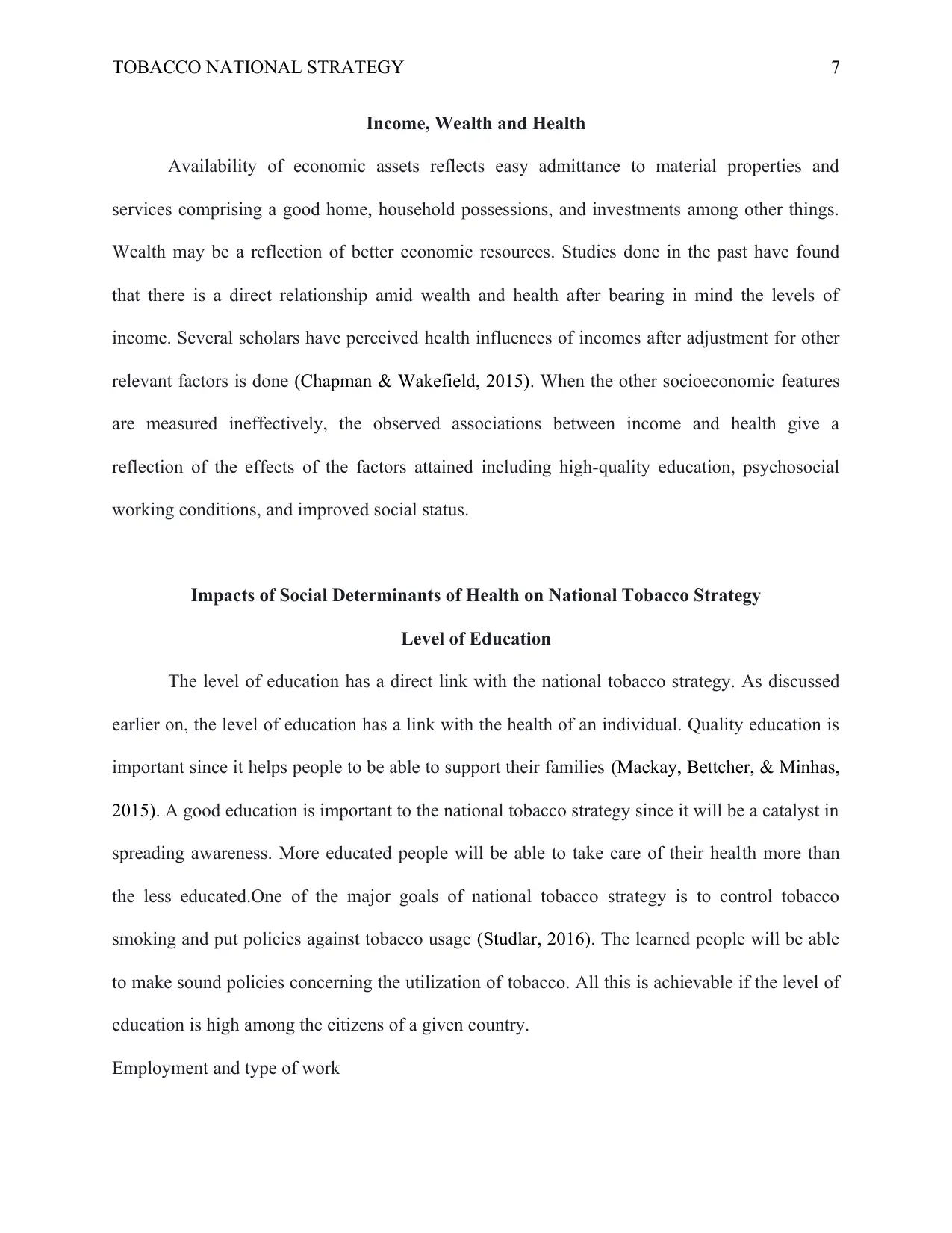
TOBACCO NATIONAL STRATEGY 7
Income, Wealth and Health
Availability of economic assets reflects easy admittance to material properties and
services comprising a good home, household possessions, and investments among other things.
Wealth may be a reflection of better economic resources. Studies done in the past have found
that there is a direct relationship amid wealth and health after bearing in mind the levels of
income. Several scholars have perceived health influences of incomes after adjustment for other
relevant factors is done (Chapman & Wakefield, 2015). When the other socioeconomic features
are measured ineffectively, the observed associations between income and health give a
reflection of the effects of the factors attained including high-quality education, psychosocial
working conditions, and improved social status.
Impacts of Social Determinants of Health on National Tobacco Strategy
Level of Education
The level of education has a direct link with the national tobacco strategy. As discussed
earlier on, the level of education has a link with the health of an individual. Quality education is
important since it helps people to be able to support their families (Mackay, Bettcher, & Minhas,
2015). A good education is important to the national tobacco strategy since it will be a catalyst in
spreading awareness. More educated people will be able to take care of their health more than
the less educated.One of the major goals of national tobacco strategy is to control tobacco
smoking and put policies against tobacco usage (Studlar, 2016). The learned people will be able
to make sound policies concerning the utilization of tobacco. All this is achievable if the level of
education is high among the citizens of a given country.
Employment and type of work
Income, Wealth and Health
Availability of economic assets reflects easy admittance to material properties and
services comprising a good home, household possessions, and investments among other things.
Wealth may be a reflection of better economic resources. Studies done in the past have found
that there is a direct relationship amid wealth and health after bearing in mind the levels of
income. Several scholars have perceived health influences of incomes after adjustment for other
relevant factors is done (Chapman & Wakefield, 2015). When the other socioeconomic features
are measured ineffectively, the observed associations between income and health give a
reflection of the effects of the factors attained including high-quality education, psychosocial
working conditions, and improved social status.
Impacts of Social Determinants of Health on National Tobacco Strategy
Level of Education
The level of education has a direct link with the national tobacco strategy. As discussed
earlier on, the level of education has a link with the health of an individual. Quality education is
important since it helps people to be able to support their families (Mackay, Bettcher, & Minhas,
2015). A good education is important to the national tobacco strategy since it will be a catalyst in
spreading awareness. More educated people will be able to take care of their health more than
the less educated.One of the major goals of national tobacco strategy is to control tobacco
smoking and put policies against tobacco usage (Studlar, 2016). The learned people will be able
to make sound policies concerning the utilization of tobacco. All this is achievable if the level of
education is high among the citizens of a given country.
Employment and type of work
Paraphrase This Document
Need a fresh take? Get an instant paraphrase of this document with our AI Paraphraser
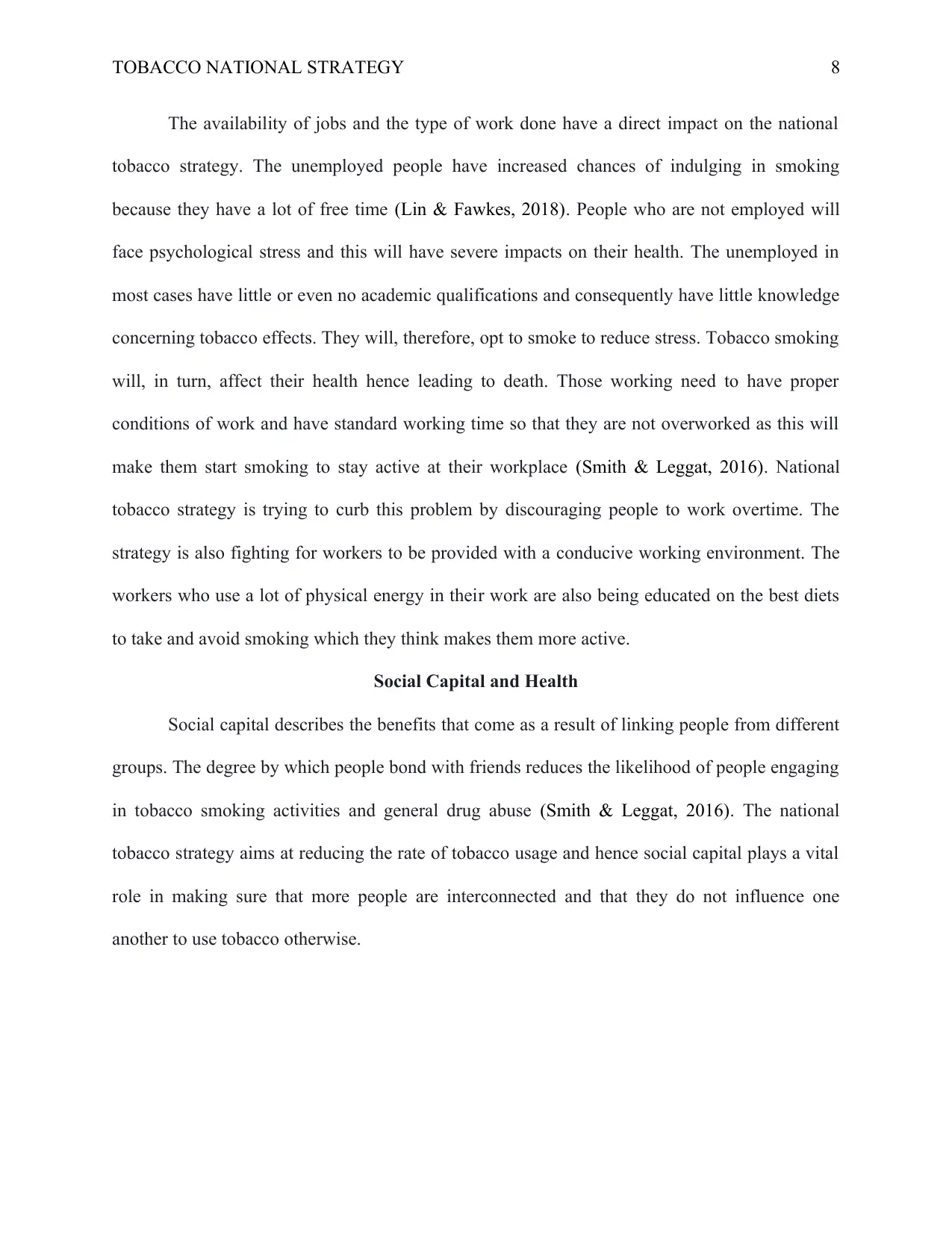
TOBACCO NATIONAL STRATEGY 8
The availability of jobs and the type of work done have a direct impact on the national
tobacco strategy. The unemployed people have increased chances of indulging in smoking
because they have a lot of free time (Lin & Fawkes, 2018). People who are not employed will
face psychological stress and this will have severe impacts on their health. The unemployed in
most cases have little or even no academic qualifications and consequently have little knowledge
concerning tobacco effects. They will, therefore, opt to smoke to reduce stress. Tobacco smoking
will, in turn, affect their health hence leading to death. Those working need to have proper
conditions of work and have standard working time so that they are not overworked as this will
make them start smoking to stay active at their workplace (Smith & Leggat, 2016). National
tobacco strategy is trying to curb this problem by discouraging people to work overtime. The
strategy is also fighting for workers to be provided with a conducive working environment. The
workers who use a lot of physical energy in their work are also being educated on the best diets
to take and avoid smoking which they think makes them more active.
Social Capital and Health
Social capital describes the benefits that come as a result of linking people from different
groups. The degree by which people bond with friends reduces the likelihood of people engaging
in tobacco smoking activities and general drug abuse (Smith & Leggat, 2016). The national
tobacco strategy aims at reducing the rate of tobacco usage and hence social capital plays a vital
role in making sure that more people are interconnected and that they do not influence one
another to use tobacco otherwise.
The availability of jobs and the type of work done have a direct impact on the national
tobacco strategy. The unemployed people have increased chances of indulging in smoking
because they have a lot of free time (Lin & Fawkes, 2018). People who are not employed will
face psychological stress and this will have severe impacts on their health. The unemployed in
most cases have little or even no academic qualifications and consequently have little knowledge
concerning tobacco effects. They will, therefore, opt to smoke to reduce stress. Tobacco smoking
will, in turn, affect their health hence leading to death. Those working need to have proper
conditions of work and have standard working time so that they are not overworked as this will
make them start smoking to stay active at their workplace (Smith & Leggat, 2016). National
tobacco strategy is trying to curb this problem by discouraging people to work overtime. The
strategy is also fighting for workers to be provided with a conducive working environment. The
workers who use a lot of physical energy in their work are also being educated on the best diets
to take and avoid smoking which they think makes them more active.
Social Capital and Health
Social capital describes the benefits that come as a result of linking people from different
groups. The degree by which people bond with friends reduces the likelihood of people engaging
in tobacco smoking activities and general drug abuse (Smith & Leggat, 2016). The national
tobacco strategy aims at reducing the rate of tobacco usage and hence social capital plays a vital
role in making sure that more people are interconnected and that they do not influence one
another to use tobacco otherwise.
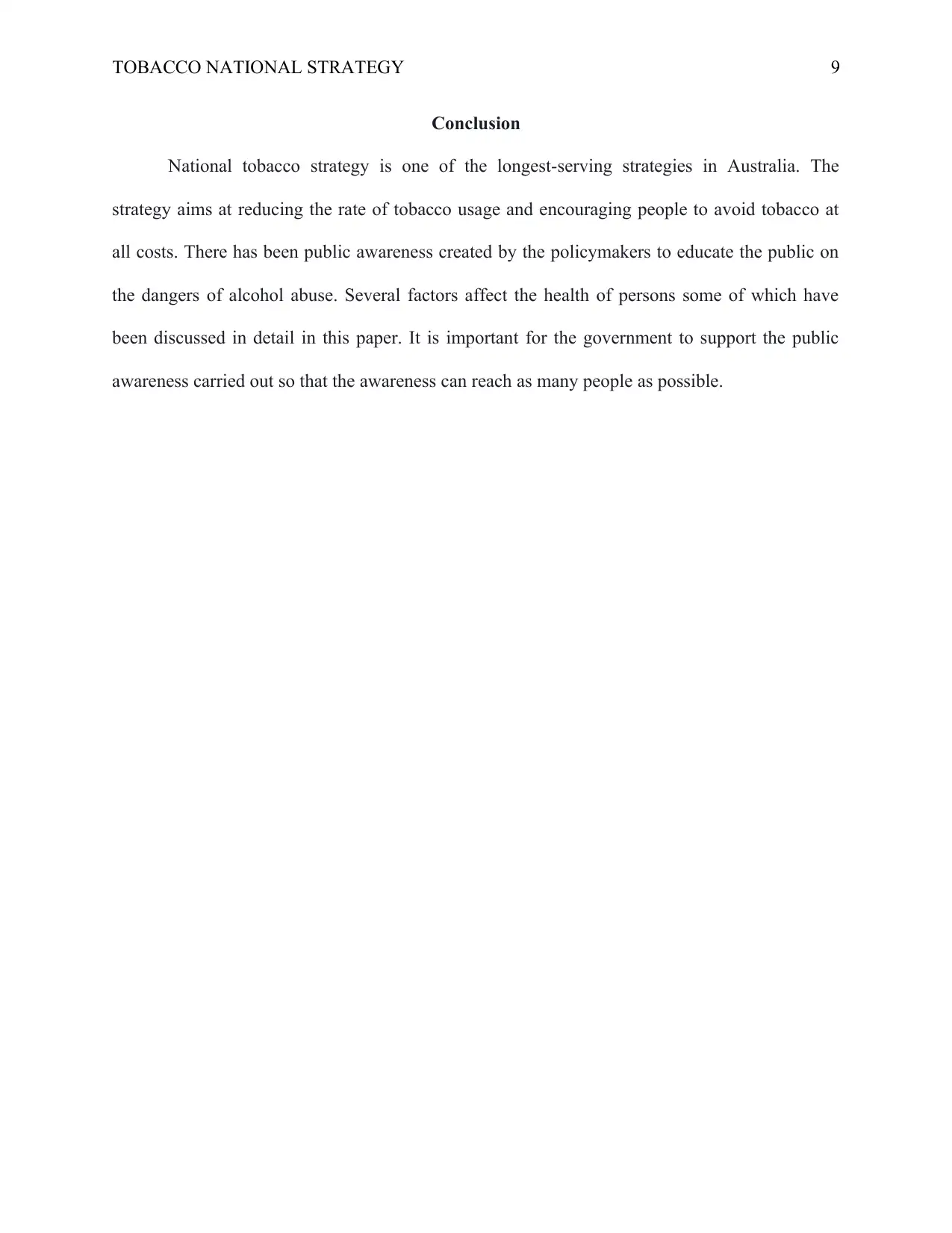
TOBACCO NATIONAL STRATEGY 9
Conclusion
National tobacco strategy is one of the longest-serving strategies in Australia. The
strategy aims at reducing the rate of tobacco usage and encouraging people to avoid tobacco at
all costs. There has been public awareness created by the policymakers to educate the public on
the dangers of alcohol abuse. Several factors affect the health of persons some of which have
been discussed in detail in this paper. It is important for the government to support the public
awareness carried out so that the awareness can reach as many people as possible.
Conclusion
National tobacco strategy is one of the longest-serving strategies in Australia. The
strategy aims at reducing the rate of tobacco usage and encouraging people to avoid tobacco at
all costs. There has been public awareness created by the policymakers to educate the public on
the dangers of alcohol abuse. Several factors affect the health of persons some of which have
been discussed in detail in this paper. It is important for the government to support the public
awareness carried out so that the awareness can reach as many people as possible.
⊘ This is a preview!⊘
Do you want full access?
Subscribe today to unlock all pages.

Trusted by 1+ million students worldwide
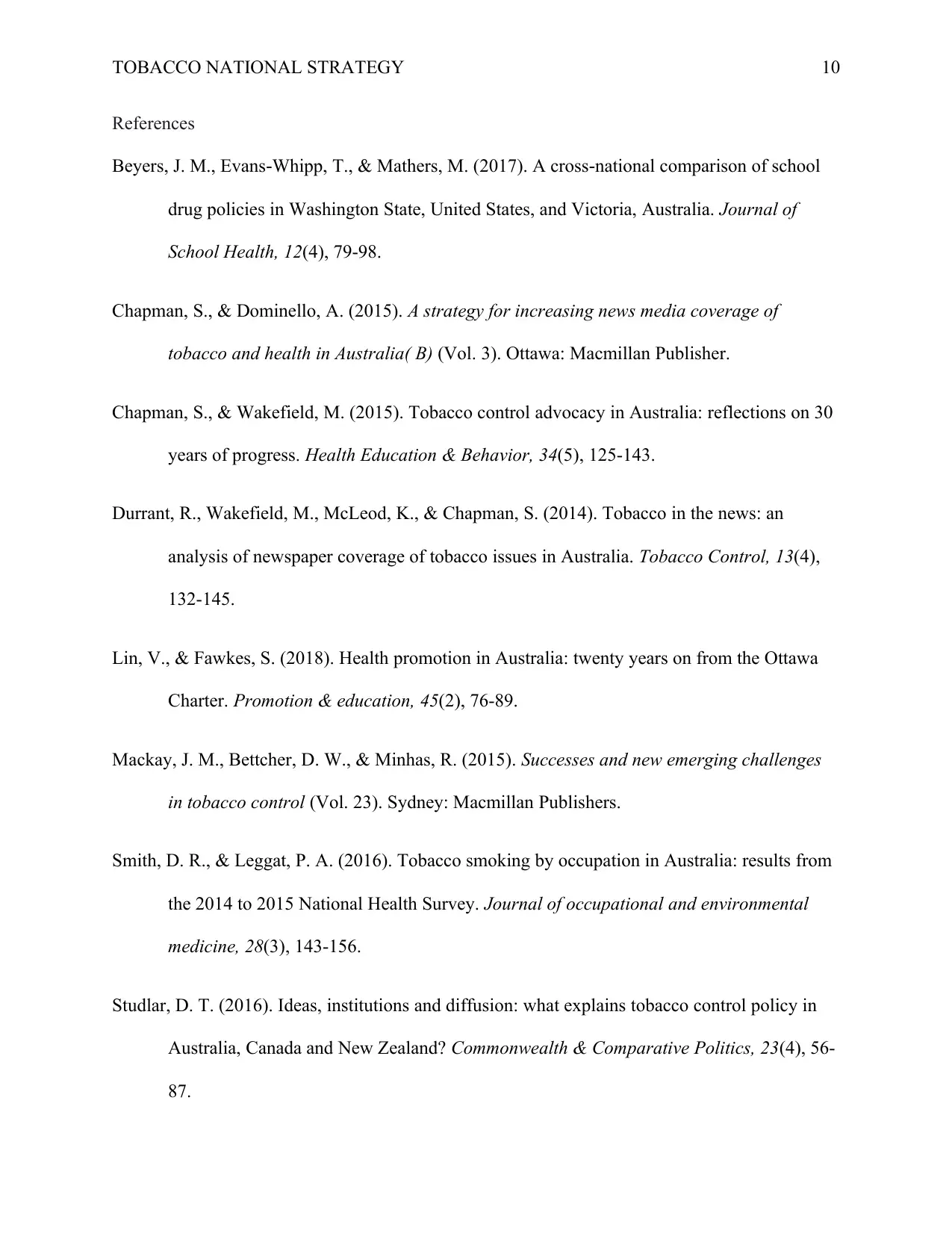
TOBACCO NATIONAL STRATEGY 10
References
Beyers, J. M., Evans Whipp, T., & Mathers, M. (2017). A cross national comparison of school‐ ‐
drug policies in Washington State, United States, and Victoria, Australia. Journal of
School Health, 12(4), 79-98.
Chapman, S., & Dominello, A. (2015). A strategy for increasing news media coverage of
tobacco and health in Australia( B) (Vol. 3). Ottawa: Macmillan Publisher.
Chapman, S., & Wakefield, M. (2015). Tobacco control advocacy in Australia: reflections on 30
years of progress. Health Education & Behavior, 34(5), 125-143.
Durrant, R., Wakefield, M., McLeod, K., & Chapman, S. (2014). Tobacco in the news: an
analysis of newspaper coverage of tobacco issues in Australia. Tobacco Control, 13(4),
132-145.
Lin, V., & Fawkes, S. (2018). Health promotion in Australia: twenty years on from the Ottawa
Charter. Promotion & education, 45(2), 76-89.
Mackay, J. M., Bettcher, D. W., & Minhas, R. (2015). Successes and new emerging challenges
in tobacco control (Vol. 23). Sydney: Macmillan Publishers.
Smith, D. R., & Leggat, P. A. (2016). Tobacco smoking by occupation in Australia: results from
the 2014 to 2015 National Health Survey. Journal of occupational and environmental
medicine, 28(3), 143-156.
Studlar, D. T. (2016). Ideas, institutions and diffusion: what explains tobacco control policy in
Australia, Canada and New Zealand? Commonwealth & Comparative Politics, 23(4), 56-
87.
References
Beyers, J. M., Evans Whipp, T., & Mathers, M. (2017). A cross national comparison of school‐ ‐
drug policies in Washington State, United States, and Victoria, Australia. Journal of
School Health, 12(4), 79-98.
Chapman, S., & Dominello, A. (2015). A strategy for increasing news media coverage of
tobacco and health in Australia( B) (Vol. 3). Ottawa: Macmillan Publisher.
Chapman, S., & Wakefield, M. (2015). Tobacco control advocacy in Australia: reflections on 30
years of progress. Health Education & Behavior, 34(5), 125-143.
Durrant, R., Wakefield, M., McLeod, K., & Chapman, S. (2014). Tobacco in the news: an
analysis of newspaper coverage of tobacco issues in Australia. Tobacco Control, 13(4),
132-145.
Lin, V., & Fawkes, S. (2018). Health promotion in Australia: twenty years on from the Ottawa
Charter. Promotion & education, 45(2), 76-89.
Mackay, J. M., Bettcher, D. W., & Minhas, R. (2015). Successes and new emerging challenges
in tobacco control (Vol. 23). Sydney: Macmillan Publishers.
Smith, D. R., & Leggat, P. A. (2016). Tobacco smoking by occupation in Australia: results from
the 2014 to 2015 National Health Survey. Journal of occupational and environmental
medicine, 28(3), 143-156.
Studlar, D. T. (2016). Ideas, institutions and diffusion: what explains tobacco control policy in
Australia, Canada and New Zealand? Commonwealth & Comparative Politics, 23(4), 56-
87.
Paraphrase This Document
Need a fresh take? Get an instant paraphrase of this document with our AI Paraphraser

TOBACCO NATIONAL STRATEGY 11
1 out of 11
Related Documents
Your All-in-One AI-Powered Toolkit for Academic Success.
+13062052269
info@desklib.com
Available 24*7 on WhatsApp / Email
![[object Object]](/_next/static/media/star-bottom.7253800d.svg)
Unlock your academic potential
Copyright © 2020–2025 A2Z Services. All Rights Reserved. Developed and managed by ZUCOL.




